#long term nuclear waste storage warning messages
Text
I'm sincerely fascinated by everything related to long term nuclear waste storage warning systems. Like if they made merch I'd be SO hyped up about it.
Like if they made a funko pop like this:

i'd buy it
#long term nuclear waste storage warning messages#not a place of honor#this is not a place of honor#nuclear waste#i photoshopped this months ago and never posted it
88 notes
·
View notes
Text
Trans girl womb tattoo but it just says "This place is not a place of honor... no highly esteemed deed is commemorated here... nothing valued is here."
161 notes
·
View notes
Text
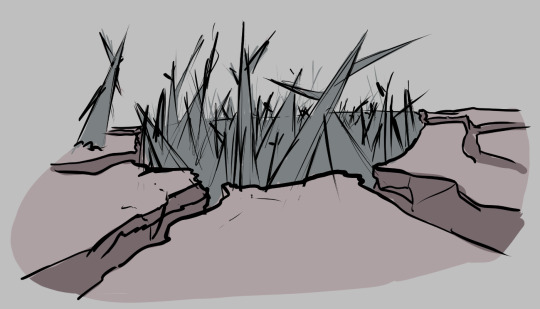
landscape doodle
a place of honor
#my art#doodle#artwork#art#sketch#landscape doodle#landscape#artist on tumblr#idk i just think long term nuclear storage stuff looks really cool#long term nuclear waste warning messages#i think that tag fits?
31 notes
·
View notes
Text
hey guys, this is a post about side order and what we can somewhat gather about it so far. this'll be a long one, so hang tight. i've seen others vaguely talk about these ideas, so i decided to go all-out.
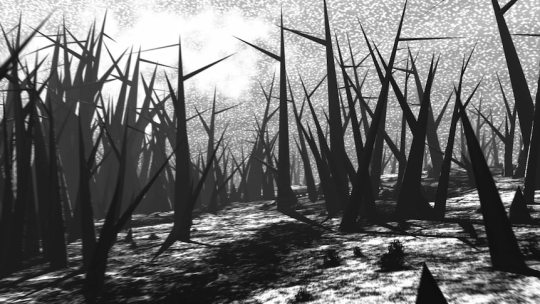
this image is of what i'm going to refer to as the 'landscape of thorns,' which is a 'long-term nuclear waste warning message.' these being used to sway humanity from intruding on highly dangerous sites.
as certain kinds of radiation can stay toxic for thousands of years, a warning of the dangers of this plant were needed. non-linguistic messages were attempted at first by a report from the sandia national laboratories, one of the three development and research laboratories of the department of energy's national nuclear security administration. {DOE, NNSA} the aim of this series of messages were to warn later visitors to any waste site. they recommended that messages include each of the following, gradually increasing complexity.
{much more under the cut.}
"1} Rudimentary information: "Something man-made is here"
2} Cautionary information: "Something man-made is here and it is dangerous"
3} Basic information: Tells what, why, when, where, who, and how
4} Complex information: Highly detailed written records, tables, figures, graphs, maps and diagrams"
the issue with worded messages is that they're unlikely to be comprehensible in thousands of years. considering how much the english language has changed, and will continue to evolve, would those of the future be able to understand what is being said? because of this, symbols were also considered.. but another problem arises with that. no symbol will be universally understood to mean one thing, even something such as the jolly roger. {☠️} using it to warn for risk of sickness, or general harm would serve useless as time passes. especially nowadays, while the jolly rodger still is seen as a danger symbol somewhat, is used more commonly as a cool design thing.. at least in the USA. and again, that's the problem. no symbol is universally known for one thing, no matter what.
i believe it was also a thought to not warn at all, and just leave it there.. but that questions ethics.
eventually, physical markers were explored, giving ideas such as the forbidding blocks, rubble landscape, the landscape of thorns, and a few beyond those. these ideas carry similar characteristics to each other.

from the official trailer.
in 1992-1993, a poll was issued by the zeitschrift für semiotik of tübingen germany, asking the following question:
"how would it be possible to inform our descendants for the next 10,000 years about the storage locations and dangers of radioactive waste?" and received answers such as artificial satellites, atomic priests, and 'ray cats.' i'm going to further talk about ray cats, as i think, considering the themes, it would be a good opportunity for side order to delve deeper into li'l judd, and his current whereabouts or motivations. as it's very vaguely hinted that he owns grizzco industries, and with that presumably dead fish in the trailer, it could be explored. i hope they won't make it weird though, as you know.. the whole thing with mammals has been a bit bizarre..
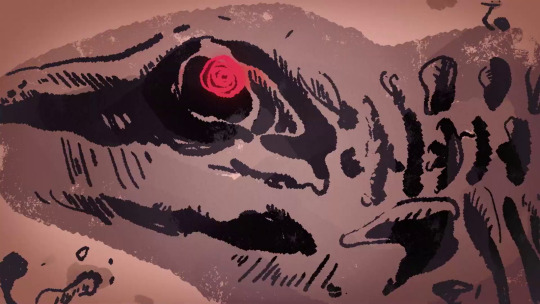
anyway, it was suggested that a species of cat should be bred that changes colors when exposed to radiation, so essentially a living sign of nuclear threat. as things such as nursery rhymes have been culturally significant in some way for many, many years.. in 2014, the musician 'emperor x' was commissioned by the podcast '99% invisible' to create a song about this idea for an episode about long-term nuclear waste warning messages.
whatever this fucker is. they could be completely done with grizzco, but who knows.
{edit 8/23/23 i've been told it resembles the bake-kujira. the ghost whale which is accompanied by "weird birds or fish."}
giving us the song '10,000-Year Earworm to Discourage Settlement Near Nuclear Waste Repositories {Don't Change Color, Kitty.}' the gist of this track being "if the cat turns bright colors, run!" and was designed to be "so catchy and annoying that it might be handed down from generation to generation over a span of 10,000 years."
youtube
so, themes of radiation are very likely to be present. this brings us to our next section, the coral bleaching.
as you may know, healthy coral has beautifully bright colors. this is due to microscopic algae known as zooxanthellae, which lives inside of the algae's polyps. it is also a major source of food, and nutrients. coral bleaching occurs when coral reefs are under stressful conditions, a huge one being climate change, which i will get deeper into that specifically. if the waters it lives in heat up too much, the coral will begin to expel this zooxanthellae.. leaving it completely white, and exposing its bone-like structure.
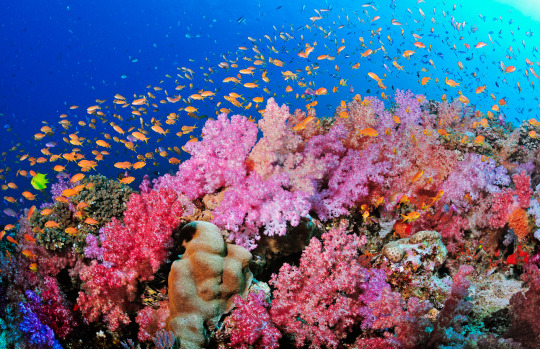
healthy vs partially bleached coral.

while bleached coral isn't quite dead, the aftermath of said bleaching makes it much more susceptible to disease and malnourishment due to lack of nutrition. if the waters stay too warm for too long, or if the bleaching is too extreme, the coral will die.

images from the official side order trailer, showing us bleached and possibly dead coral.
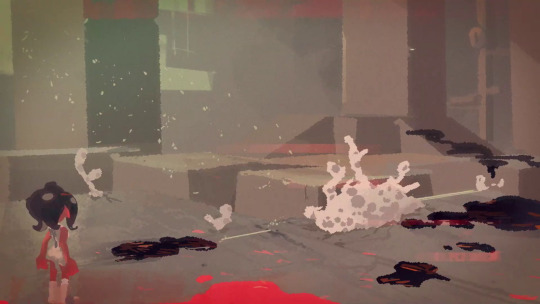
coral bleaching is an ongoing issue, and efforts have been made to conserve and regrow the coral reefs.. this brings us to a shorter section, but one worthy of a mention.
coral cloning. coral cloning is a phenomenon where a small bit of a healthy coral is cut, and grows into a full piece. it helps when this, sometimes miniscule, piece is placed next to another. this speeds up growth almost rapidly. however, it is not too easy to grow, and this method isn't totally fool-proof. coral requires very certain conditions to flourish, such as not being placed on an open ocean floor, but instead in an already established habitat. also things like water temperature, pH levels, pollution, all can stunt growth. this is a very vast oversimplified explanation, but i believe you get the picture. have you wondered why i am bringing this up? here is why..

am i saying this directly implies cloning? not exactly. it's an interesting thing to note, though, as you might know how octarians {NOT OCTOLINGS!} are born.. via severed tentacle. coral can sometimes be born via severed piece. i'm not going to go into this much more, as it's kind of an out-there comparison. do with that what you will.
continuing on with the radiation and infectious theme, i feel i should mention ultraviolet radiation. the sun produces these UV rays, of course, and they can be good in moderation. if it's too much? it can be absolutely killer. you guessed it, ultraviolet radiation does play a part in warmer waters, which aids in bleaching coral. however, that's not all.. the state of inkopolis square we see in the side order trailer could very well also be due to residue of nuclear radiation from the human society's many wars. before humanity's fall, natural disasters were more prevalent than ever, and we still don't really know what exactly happened besides the massive flood. the sea levels rising was the reason the great turf war, the deadliest war to strike inkadia, even happened. things like oil spills could possibly be going on too, as in some photos, you can see this black liquid.
i'm going to state the obvious and add on that oil spills are incredibly dangerous to marine life, and that includes coral reefs.

remnants of human life have not disappeared from inkadia, or anywhere in this world dominated by marine life. it's not far-fetched to say they could still be affected by anything else left behind, climate wise.
the landscape of thorns has not been built, to my knowledge, but maybe it was here. this could be a rediscovered nuclear plant, who knows. especially as certain kinds of radiation, again, can stay hazardous for upwards of ten-thousand years, and possibly longer. you may have caught that ten-thousand is an important number for multiple reasons, especially with the possibility that this octoling is eight. the human race has been extinct for longer than ten-thousand years by this point, but it's something to remember. but there's still questions.. where do pearl and marina fall now? what is their role? is this an infection only targeting octolings, and other octarians? what's going on with marina? only time will tell, yeah?
there you have it, if you read this far.. definitely tell me what you think. i've still not covered everything in the trailer, so any add-ons would be cool if you have any. this took a while to research and write, so thanks for reading.
sources:
https://en.wikipedia.org/wiki/Coral_bleaching
https://www.scientificamerican.com/article/scientists-are-taking-extreme-steps-to-help-corals-survive/
https://www.worldwildlife.org/pages/everything-you-need-to-know-about-coral-bleaching-and-how-we-can-stop-it
https://response.restoration.noaa.gov/about/media/how-do-oil-spills-affect-coral-reefs.html
https://youtu.be/JENUAv0w8Q4
https://youtu.be/ZiULxLLP32s
https://en.wikipedia.org/wiki/Long-term_nuclear_waste_warning_messages
https://www.bbc.com/future/article/20200731-how-to-build-a-nuclear-warning-for-10000-years-time
https://youtu.be/dDIMYAYSGCo
121 notes
·
View notes
Text
the black sea but especially the hole in the sea fits perfectly the long term nuclear waste storage warning message
#DO YOU SEE MY VISION#CAN YOU FUCKING SEE IT#I HEARD IT AND AS I MADE THE CONNECTION I COULD NOT LET IT JUST SIT IN MY BRAIN#jrwi#jrwi riptide#riptide#the black sea
33 notes
·
View notes
Text
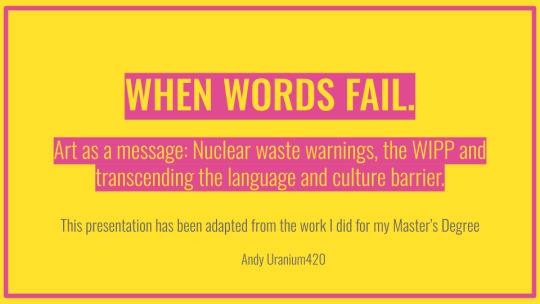
Hello! I wrote this symposium presentation for my master's degree in artistic practise in 2022 :) If you would like to cite this symposium please message me off-anon and I will give you the details needed :)
I considered adapting this presentation into essay format for tumblr, however that would be a massive effort, given that all my sources for this presentation are not formatted for the essay structure.
This is NOT a quick read, but I appreciate you even considering reading :) thank you!
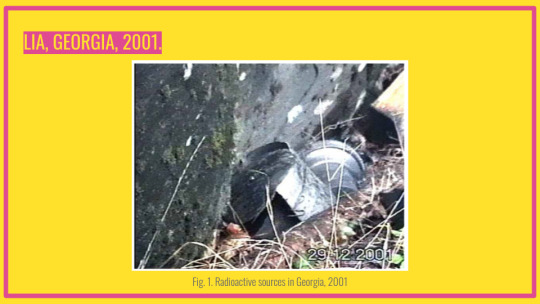
It’s 2nd December 2001, near the Enguri Dam, Georgia. Three men walk into a nearby forest, looking for firewood. The winter sun sets early so the men decide to spend the night in the forest and take the wood back to their trucks the next morning. Around 6pm they find two strange objects, cylindrical in shape, and 15 cm in length. The snow around these objects is melted, and the wet soil is steaming from the heat. One of the men picks up one of the objects, and drops it immediately, as it is too hot to hold. They decide to use the objects as personal heaters, while they sleep in the forest waiting for daylight. They begin to feel sick; so sick they don’t sleep, and spend all night vomiting. The next morning they only load half the firewood into their truck, they are exhausted.
It’s 22nd December 2001. All three men are admitted to hospital. On 23rd January 2002, one of the men is discharged from hospital. On 18th March 2003, a second man is discharged from hospital. On 13th May 2004, the third man dies, having never been well enough to leave.
What they found were radioactive sources of Strontium-90, removed from radioisotope thermoelectric generators, which were scrapped and abandoned upon Georgia’s independence from the Soviet Union, and the termination of the project for which they were to be used. They killed one person, and injured two more. They held no warning signs, marks, or messages.

Art has been used as a form of communication ever since people have been making art. It can transcend current language barriers by virtue of shared cultural ideas and representational imagery, especially in the modern day where we have more access to shared culture and art than ever. Art is hard to define, and there still isn’t a consensus on what it is, however, as journalist Daniel Oberhaus notes, many people know it when they see it. He also notes that cultural context plays an important role in the understanding of art; a urinal is not art, unless it is displayed in a gallery. In The Philosophical Disenfranchisement of Art, Arthur Danto explicitly states that it was a urinal, until it became a work of art- the cultural knowledge of an art gallery changes the meaning of the piece. Niklas Luhmann in his essay The Medium of Art explores the idea that works of art exist to communicate meaning before anything else; that they are produced of a medium, and then become a medium themselves, one of communication. So what do we do, then, when neither consistency of language nor culture is guaranteed? What do we do when art must communicate messages to people so far in the future we cannot make any assumptions about the preconceptions a viewer will bring, or the culture in which they operate? What do we do when the message we have to bring to them is extremely important, and does not leave room for misinterpretation?
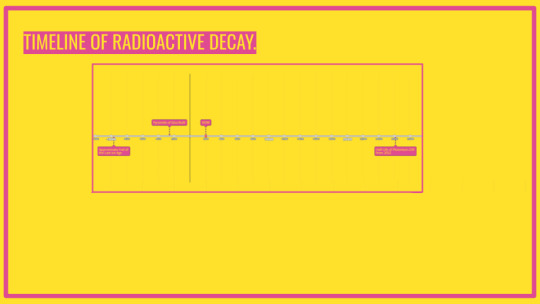
One message that is incredibly important for humans now to send is marking our long term deep geological nuclear waste repositories as dangerous and the areas above them as uninhabitable. However, working with nuclear isotopes, and their long half-lives, confronts us with the aforementioned questions; the message is extremely important, cannot be misinterpreted, and we can safely assume any viewer will share no language or culture with us today.
Most storage involves transuranic elements- that is, isotopes heavier than uranium- used for both creation of nuclear arms, and nuclear power stations, with two of the most common contaminants being Plutonium-329 and Uranium-235. This is the half-life of Plutonium-329.

And this is the half-life of Uranium-235.
And this is the time scale on which people have had to think to design warnings for the Waste Isolation Pilot Plant, in New Mexico, USA- licensed to store waste from nuclear arms development which opened for operation in 1999, and is due to be backfilled between 2025 and 2035.
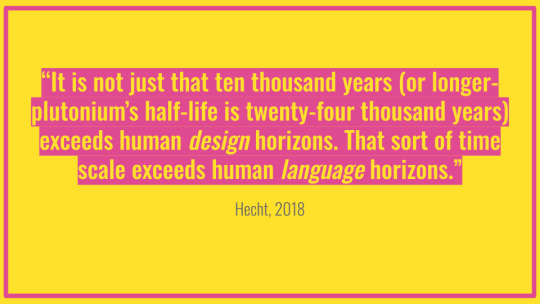
Gabrielle Hecht said of the issue in 2018, “It is not just that ten thousand years exceeds human design horizons. That sort of time scale exceeds human language horizons.”
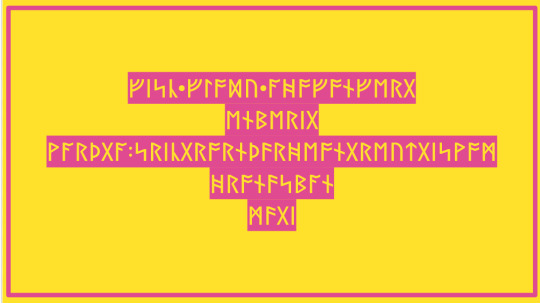
To put a bit of context to these unthinkably large numbers and the issue with communicating over time spans on this scale, this is a fragment of Old English from the Franks Casket, written in Anglo-Saxon runes. This is estimated to have been written only 1,300 years ago. It is unintelligible to English speakers today.
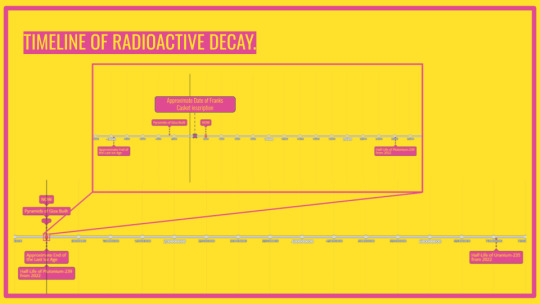
And to put that onto the timeline, we can see the distance in time between the Franks Casket and now is tiny compared to how long the warnings need to last. In his letter declining the invitation to join the Sandia National Laboratories report on nuclear waste markers, Carl Sagan described the problem as such:

“... artistic conventions, written and spoken language… might, for all we know, change drastically. What we need is a symbol invariant to all those possible changes. Moreover, we want a symbol that will be understandable not just to the most educated and scientifically literate members of the population but to anyone who might come upon this repository.”
Sagan brings up a very important point: the need for any symbol to be universally understood, regardless of the viewer's education, age, or cultural background. This, I think, is the largest obstacle we face, given that we didn’t even have this problem solved until 2007, despite having infinite access to research the people that live now.

In 2001 the International Atomic Energy Agency and International Organisation for Standardisation were faced with the challenge of making a new symbol to denote immediate severe radiation hazard after a 2000 incident, where three people in Samut Prakan province, in Thailand, died from radiation exposure after coming across a cobalt-60 source, previously used for cancer radiotherapy, in a scrap yard. The source was secured properly (although not disposed of properly), and displayed the proper warning symbols, but it made no difference, because the people didn’t recognise the symbol, and none of the written warnings were in Thai.
The original warning design was conceived at the University of California Berkeley Radiation Laboratory in 1946, by a group of people who were doodling out designs that could be used to symbolically represent radiation hazards. Nels Garden, one of the scientists involved in the designing process, gave insight into the design in letters sent after the event. The design was supposed to represent an atom emitting radiation. The first design was this one, with the magenta trefoil on the blue background. Magenta was chosen because it didn’t conflict with any existing colour coding rules, and the ink was expensive, which they hoped would ensure people did not use the symbol frivolously and reduce its impact as a warning. The blue was chosen because there were no other blue warnings and labels used in radioactive work of the time, meaning it was distinctive, however it received criticism for being low visibility, as well as the fact that blue was not supposed to be used on warning signs, as it fades quickly.
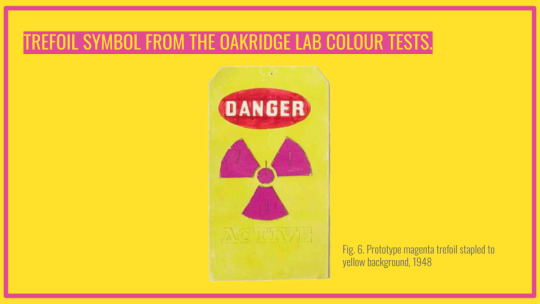
In 1948 yellow was standardised for the sign at the Oakridge National Lab, following requests for a standardised colour scheme, after a committee viewed the magenta symbol stapled to different coloured cardboard, and deemed magenta and yellow the best combination. Until its final standardisation by the American National Standards Institute in the 1950s, there were a few variations of the symbol. In 1974 the ISO approved a design for international use, in which the trefoil is black instead of magenta.

And, in a town in Thailand, none of that mattered. Faced with foreign language warnings and a symbol none of the scrapyard workers recognised, the immediate danger they were in was not adequately communicated by the trefoil. The 2001 assignment, the New Warning Symbols Project, needed a symbol that would unfailingly communicate “danger, run away, do not touch.” In 2007 they presented the high level sealed-source ionising radiation symbol. In target groups of children of many nationalities, the trefoil symbol meant something like a propeller or a windmill, and the colour yellow did not indicate the immediate life threatening danger. In many more tests conducted around the globe, they settled on the current design as being the one that most clearly portrayed the message without words. Of all the symbols tested, skull and crossbones was the only one that consistently conveyed the meaning of “this may harm you so much that you will die.” The yellow was replaced with red to move the warning from “caution” to “active danger” in the eyes of viewers.

The result of the research echoes what Sagan wrote in his letter to Sandia Labs, recommending skull and crossbones as symbols to be placed around the WIPP, which he said has “unmistakable” meaning, referring to pirate flags, bottles of poison, and Nazi divisions- all things which are bad and to be avoided; although the report itself points out that in Mexico bones are considered to hold life force, so alternative messages would also be required, especially considering the WIPPs proximity to the US-Mexico border, and Oberhaus points out that it only emerged as a symbol of toxicity relatively recently, that is- recently on the scale of radioactive isotopes, with no guarantee it will last.
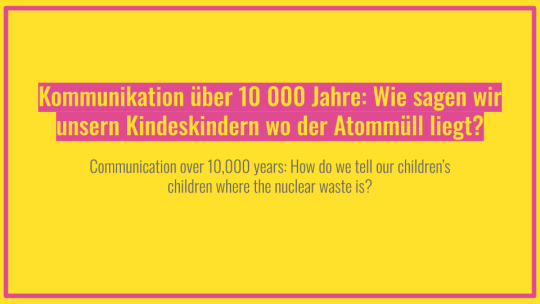
The first published attempt to solve the problem of producing a universally understood message that is as clear in 100 years as it is in 10,000, though posed as a thought experiment rather than as part of government action like the at the time recently formed Human Interference Task Force, was the 1982/1983 poll in the Berlin Institute of Technology’s Journal of Semiotics, which asked “How do we tell our children’s children where the nuclear waste is?”
The suggestions with the least amount of subsequent research (or, at least, subsequent research in English) are, with one exception, the most conceptually mundane, so I will only give an overview of the exciting one. Polish science fiction writer Stanislaw Lem suggested satellites that endlessly transmit the messages back to Earth. He also proposed encoding messages into the DNA of plants that he dubbed Atomic Flowers which would replicate and renew into forever. He suggested that the plants be only grown in the vicinity of the repositories, and contain information about the danger of the camp. The major issue with this, pointed out by Lem himself, was who would ever even think to decode DNA for a hidden message? And if the message was known about would they consider the decoding an endeavour worth pursuing.
Two of the suggestions connected to this poll are more fleshed out, the Ray Cat Solution and the Atomic Priesthood.
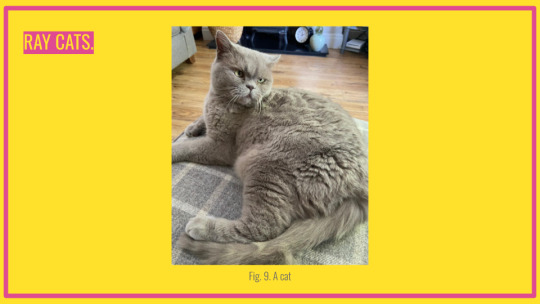
The Ray Cats solution is my personal favourite, in theory. In reality it's wholly problematic, for ethical reasons.
Ray Cats proposes genetically engineering cats to change colour in the presence of radiation, and the message will be passed down and preserved via fairy tales, poems, and nursery rhymes- which are typically long lived and cross-culturally intelligible. It hopes to build off the superstition surrounding black cats- either bad luck or good luck depending on where you are, and your cultural background.
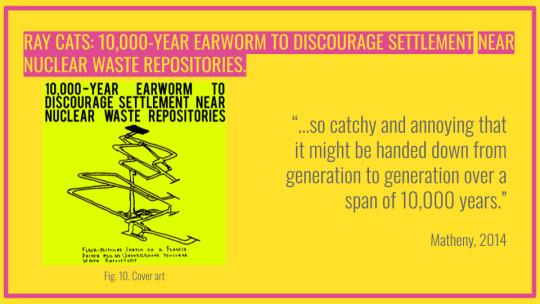
One such cultural marker was a song written 2014 by physicist turned musician Chad Matheny, also known as Emperor X, who described the brief as to create a song “so catchy and annoying it might be handed down… over a span of 10,000 years.” It was titled “10,000-Year Earworm to Discourage Settlement Near Nuclear Waste Repositories”
Beyond the song, there isn’t much art here. There’s a lot of science, and a lot of ethics, but little has been considered artistically.
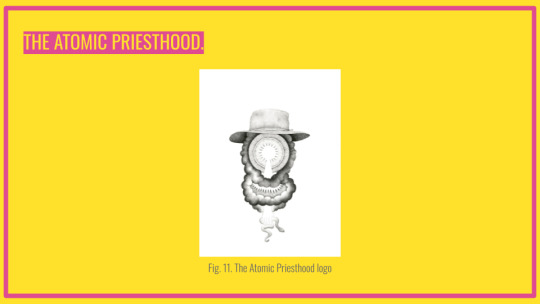
The concept from this poll which has been expanded upon the most is the Atomic Priesthood, suggested by linguist Thomas Sebeok, and it is currently being developed by the Atomic Priesthood Project- a collective of artists working towards preserving the messages of the dangers of nuclear waste and their locations. The Atomic Priesthood is built from the principle that the Catholic Church has survived with a pretty consistent message for 2000 years, and had to convene groups to enact significant change in their doctrine. For example, they would create rituals and myths surrounding the consequences of disturbing the waste. They would dictate which areas are forbidden, and dictate what retribution awaits those who disobey, literal or metaphysical. Issues with this idea arose almost immediately, for example schisms akin to the Protestant Reformation distorting the message, and what happens if Nuclear Atheists emerge, denying the existence of the danger?
Despite the issues, a lot of lore, doctrine, and rite has been established for the Atomic Priesthood. They have worked in collaboration with many artists across many disciplines, including Dana Sherwood, Helen Lee, Duy Hoang, Claire Beaumont and many more.
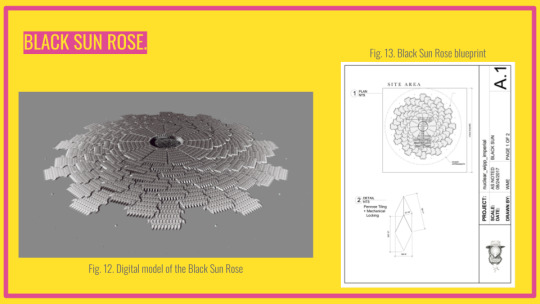
One of their projects, beginning in 2017, was to develop nuclear warning monoliths. They used the WIPP as a base, and followed the guidelines set out in the 1993 Sandia Labs report on Expert Markers to Deter Inadvertent Human Intrusion into the Waste Isolation Pilot Plant, and came up with the Black Sun Rose. They are interlocking monoliths, following a Penrose pattern - meaning they can be tiled infinitely outwards. The blocks are to be cast from black dyed concrete; concrete being readily available and extremely long lasting, and dyed black to discourage animal and human habitation on the site, due to its absorption of New Mexico desert heat. The structure must be at least 4 square miles, large enough to fully cover the underground footprint of the site. At this size, it will also be visible from space.
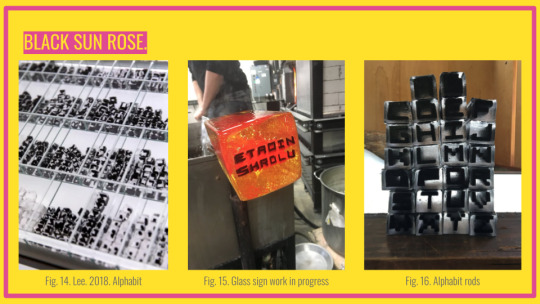
They will also use glass for the embedding of written messages. Glass will be used as it is the most geologically stable and chemically inert material that can be mass produced. The messages will be produced by embedding coloured rods in clear glass, making a sort of 3 dimensional font, based on the work ‘Alphabit’ by Helen Lee. The letters can then be fused into one large wall, with the rods being slightly curved to bounce sunlight through the rods, using the same principle as fibre optic cables. This will cause the walls of text to illuminate. The properties of the glass mean that any writing system or image that can be embedded in this way will not be obscured or removed by damage. This seemingly solves the issue that arises with stone carvings, where chipping of stone can make the message unintelligible.
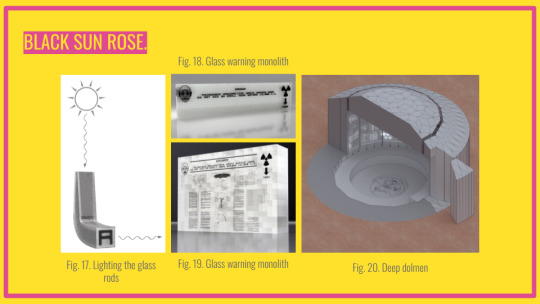
The rose structure will be perimetered by kiosks, containing the glass panels, and they will warn people to leave, and of the danger, in various languages and through pictograms. There will also be “deep dolmen” and these will be created of the same penrose blocks as the rest of the structure, and be entirely enclosed, with no way of access except removing one of the large blocks- a daunting, but not impossible task, depending on the technological level of the people who find them. The hope is that uncovering something, anything through means of brute force and excavation will be enough of a satisfying result for intruders that the actual danger remains undisturbed. The information stored in these will be much more in depth than what is displayed in the kiosks, but also redundant, such that if they are never opened, the message of the whole site remains intelligible and complete.
As of 2020, these designs are just a proposal.
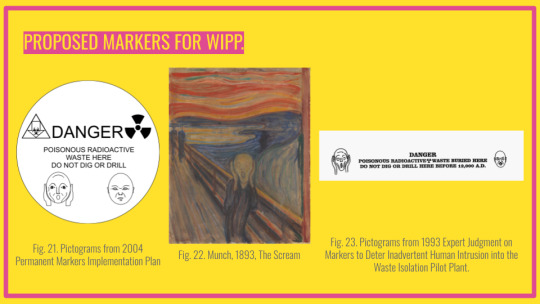
The largest body of research and design concepts comes from the aforementioned 1993 Expert Judgment on Markers to Deter Inadvertent Human Intrusion into the Waste Isolation Pilot Plant produced by Sandia National Laboratory for the United States Department of Energy.
One of the things it covers is the use of pictograms. Working under the assumption that any language spoken today will be gone, they decided that using pictograms along with written warnings would stop the warning signs from becoming entirely obsolete after the extinction of current languages.
The pictograms are more faces and less abstract representations. Usage of Munch’s The Scream was done to portray “abject horror and terror”, and the report concludes that usage of faces is most suitable for cross-cultural intelligibility, as the expressions associated with fear, apprehension, and disgust, are universal. A 2009 study by Matsumo and Willingham analysed the spontaneous expressions produced by congenitally blind, non-congenitally blind, and sighted athletes, and found that there was little difference between the facial emotion configuration between the groups, and no difference at all cross-culturally. So using faces is likely a good call, because unless humans are wiped out and replaced by something else, there shouldn’t be much major change in cultural understanding of expressions, as at least something about them appears to be innate.

They also considered large structural designs that would go on to inspire the Atomic Priesthood’s Black Sun Rose. As well as emphasising the fact that the structures need to only deny land habitation and produce deep emotional response in the viewer, the report described the designs as provoking feelings of “danger to the body”, “fear of the beast”, “dark forces emanating” and “abyss.”
A 2012 study showed that shapes with sharp abrupt angles are associated with emotions with abrupt onset, such as surprise and anger, and a 2021 study showed, using 3d objects instead of 2d drawings, spiked objects being associated with unpleasant, uncontrolled and high arousal emotions, and we can see this from the designs presented in the report, although no specific research of the kind is mentioned.
The structures are separated into two groups:
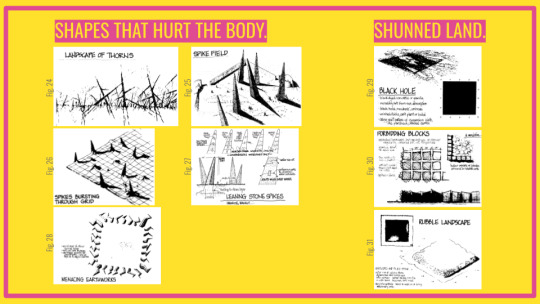
Shapes that hurt the body, and shunned land.
The report describes them as such:
Danger seems to emanate from below. The shapes suggest wounding forms, like thorns and spikes, even lightning. They seem active, in motion cut and up, moving in various directions. They seem not controlled. Walking through it, at ground level, the massive earthworks crowd in on you, dwarfing you, cutting off your sight to the horizon, a loss of connection to any sense of place.
And:
An image of an enormous black hole; an immense nothing; a void; land removed from use with nothing left behind; a useless place. It is a massive effort to make a place that is fearful, ugly, and uncomfortable.
An anomaly both topographic and in roughness of material. An enormous landscape of large-stone rubble, one that is very inhospitable, being hard to walk on and difficult to bring machinery onto. It is a place that feels destroyed, rather than one that has been made. They are deliberately irregular and distorted cubes. The cubic blocks are set in a grid, defining a square, with 5-foot wide’’streets” running both ways. You can get “in” it, but the streets lead nowhere, and they are too narrow to live in, farm in, or even meet in. It is a massive effort to deny use. It is an ordered place, but crude in form, forbidding, and uncomfortable.
None of our designs use any of the regular or “ideal” geometric forms. Why? The geometry of ideal forms, like squares and cubes, circles and spheres, triangles and pyramids is a fundamental human invention, a seeking of perfection in an imperfect world. Historically, people have used these ideal forms in places that embody their aspirations and ideals. In our designs, there is much irregularity both of forms and in their locations and directions, yet done by people with obvious knowledge of pure geometry. This shows an understanding of the ideal, but at the same time a deliberate shunning of it... suggesting we do not value this place, that it is not one that embodies our ideals.
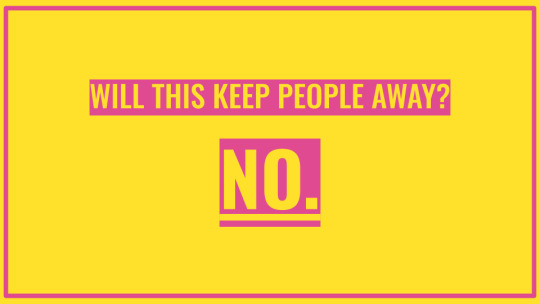
And will any of this work?
No. At least in my opinion.
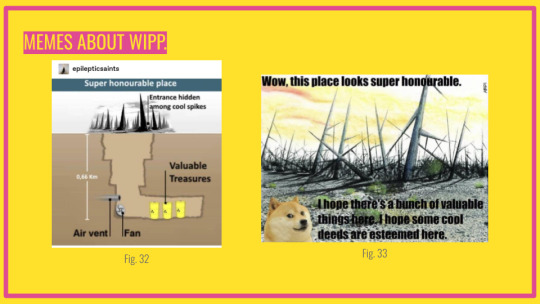
Already the WIPP and its warning messages and structures have become memes; framing the forbidding spires as cool formations that must be there to protect the valuable treasure below.
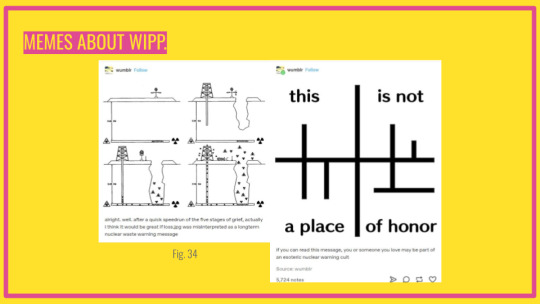
A tumblr user compares an image from the Sandia National Labs report to the meme Loss.jpeg, and jokes that Loss will be interpreted in the future as a nuclear waste warning. And it’s funny, I think it is a funny bit, but underlying a lot of the jokes about these markers is a resignation that we already know none of this will prevent intrusion into the sites.
Physicist Woodruff Sullivan points out in the report that it’s largely a self correcting problem anyway. Nothing is as good a deterrent for disturbing nuclear waste as the consequences of disturbing nuclear waste; but that view requires people to potentially die over and over as each new generation finds the site.
But on the prospect of a more artistic warning, Jon Lomberg succinctly states that:
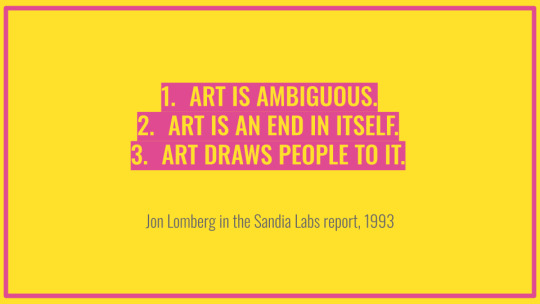
One. Art is ambiguous
Two. Art is an end in itself.
Three. Art draws people to it.
And I am tempted to agree with him.

As “One can hardly imagine a more titillating prospect for archaeologists of the future.”
youtube
And here is the 10,000 year earworm.
List of Figures:
Figure 1. International Atomic Energy Agency (2014) The Radiological Accident in Lia, Georgia. Vienna: International Atomic Energy Agency. pp. 14
Figure 2. Duchamp, M. 1917, replica 1964. Fountain. [Readymade] At: London: Tate Modern. T07573
Figures 3, 5 & 7. Chung, N. (2018) Radiation Symbol (1948) Available at: https://medium.com/fgd1-the-archive/radiation-symbol-1948-fcc2ddc33ff0
Figure 4. Origin of the Radiation Warning Symbol (Trefoil) (no date) Available at: https://www.orau.org/health-physics-museum/articles/radiation-warning-symbol.html
Figure 6. Prototype Trefoil Warning Sign with Yellow Background (1948) (no date). Available at: https://www.orau.org/health-physics-museum/collection/warning-signs/prototype.html
Figure 8. Trauth, K.M., Hora, S.C. and Guzowski, R.V. (1993) ‘Expert judgment on markers to deter inadvertent human intrusion into the Waste Isolation Pilot Plant’, Office of Scientific & Technical Information Technical Reports. pp. G-13
Figure 9. Hargreaves, A. 2022. Literally just a photograph of my cat, Luna. [Photograph]
Figure 10. Matheny, C. (2014) 10,000-Year Earworm to Discourage Settlement Near Nuclear Waste Repositories. Available at: https://emperorx.bandcamp.com/album/10000-year-earworm-to-discourage-settlement-near-nuclear-waste-repositories
Figures 11-13, & 15-20, Black Sun Rose (WIPP) (2017). Available at: http://www.theatomicpriesthoodproject.org/artists#/black-sun-rose-wipp
Figure 14. Lee, H. 2018. Alphabit. [Glass murrine, stainless steel, aluminum, acrylic, LEDs] Available at: https://pink-noise.org/portfolio/alphabit/
Figure 21. United States Department of Energy (2004) Permanent Markers Implementation Plan. Carlsbad: Washington Regulatory and Environmental Services an affiliate of Washington TRU Solutions, LLC. pp. 23
Figure 22. Munch, E. 1893. The Scream. [Oil, tempera, pastel, and crayon] At: Oslo: Nasjonalgalleriet. NG.M.00939
Figure 23. Trauth, K.M., Hora, S.C. and Guzowski, R.V. (1993) Expert judgment on markers to deter inadvertent human intrusion into the Waste Isolation Pilot Plant. Albuquerque: Sandia National Laboratories. pp. F-115
Figures 24-31. Trauth, K.M., Hora, S.C. and Guzowski, R.V. (1993) Expert judgment on markers to deter inadvertent human intrusion into the Waste Isolation Pilot Plant. Albuquerque: Sandia National Laboratories. pp. F-61-F-75
Figure 32. Love How This Implies That After The Downfall Of Humankind That Doge Is The Species To Supercede Us. (2020) Available at: https://parakavka.tumblr.com/post/635856004706418688/
Figure 33. #super honourable place. (2022) Available at: https://epilepticsaints.tumblr.com/post/696755723763367936
Figure 34. alright. well. (2021) https://wumblr.tumblr.com/post/646314177178255360/wumblr-alright-well-after-a-quick-speedrun-of
Bibliography:
Atomsemiotik (no date). Available at: https://www.chemie.de/lexikon/Atomsemiotik.html
Barrett, R. and Stephens, L. D. (1978) A Brief History of a “20th Century Danger Sign.” Berkeley: Lawrence Berkeley National Laboratory. Available at: https://escholarship.org/uc/item/7cz9p0m6#main
Benford, G. (2001) Deep Time: How Humanity Communicates Across Millennia. New York City: Avon Books
Dahlstrom, D. (2007) ‘New Symbol Launched to Warn Public About Radiation Dangers’, International Atomic Energy Agency. Available at: https://www.iaea.org/newscenter/news/new-symbol-launched-warn-public-about-radiation-dangers
Fakultät I Geisteswissenschaften: Bd_6_Hft_3 (no date). Available at: https://www.semiotik.tu-berlin.de/menue/zeitschrift_fuer_semiotik/zs-hefte/bd_6_hft_3/
Griffenhagen, G. and Bogard, M. (1999) History of Drug Containers and Their Labels. Madison: American Institute of the History of Pharmacy.
Hecht, G. (2018) ‘Interscalar Vehicles for an African Anthropocene: On Waste, Temporality, and Violence’, Cultural Anthropology 33, no. 1
Human Interference Task Force (1984) Reducing the Likelihood of Future Human Activities That Could Affect Geologic High-level Waste Repositories. Technical Report. Columbus: Office of Nuclear Waste Isolation. Available at: https://www.osti.gov/servlets/purl/6799619
Ialenti, V. (2020) Deep Time Reckoning: How Future Thinking Can Help Earth Now. Cambridge: The MIT Press.
International Atomic Energy Agency (2002) The Radiological Accident in Samut Prakarn. Vienna: International Atomic Energy Agency. Available at: https://www-pub.iaea.org/mtcd/publications/pdf/pub1124_scr.pdf
International Atomic Energy Agency (2014) The Radiological Accident in Lia, Georgia. Vienna: International Atomic Energy Agency. Available at: https://www-pub.iaea.org/MTCD/Publications/PDF/Pub1660web-81061875.pdf
Jess and Zak (2016) “The Puzzling Meaning and Origin of the Radiation Sign,” University of California Research blog. Available at: https://ucresearch.tumblr.com/post/148796081116/the-puzzling-meaning-and-origin-of-the-radiation
Kawahara, S., and Shinohara, K. (2012). A tripartite trans-modal relationship among sounds, shapes and emotions: A case of abrupt modulation. Proceedings of the Annual Meeting of the Cognitive Science Society, 34, pp. 569-574. Available at: https://escholarship.org/uc/item/47b452vw
Lin, A. et al. (2021) “Feeling Colours: Crossmodal Correspondences Between Tangible 3D Objects, Colours and Emotions,” Proceedings of the 2021 CHI Conference on Human Factors in Computing Systems. Available at: https://doi.org/10.1145/3411764.3445373
Lodding, L. (2007) ‘Drop It and Run! New Symbol Warns of Radiation Dangers and Aims to Save Lives’, International Atomic Energy Agency Bulletin, 48(2), pp. 70-72. Available at: https://www.iaea.org/sites/default/files/publications/magazines/bulletin/bull48-2/48202087072.pdf
Macfarlane, R. (2019) Underland: A Deep Time Journey. London: Penguin Books
MacKenzie, C. (2006) ‘Reducing the Risk from Radioactive Sources’ International Atomic Energy Agency Bulletin, 47(2), pp. 61-63. Available at: https://www.iaea.org/sites/default/files/publications/magazines/bulletin/bull47-2/47202006163.pdf
Matheny, C. (2014) 10,000-Year Earworm to Discourage Settlement Near Nuclear Waste Repositories. Available at: https://emperorx.bandcamp.com/album/10000-year-earworm-to-discourage-settlement-near-nuclear-waste-repositories
Matsumoto, D. and Willingham, B. (2009) “Spontaneous facial expressions of emotion of congenitally and noncongenitally blind individuals.,” Journal of Personality and Social Psychology, 96(1), pp. 1–10. Available at: https://doi.org/10.1037/a0014037
Oberhaus, D. (2019) Extraterrestrial Languages. Cambridge: The MIT Press.
Origin of the Radiation Warning Symbol (Trefoil) (no date). Available at: https://www.orau.org/health-physics-museum/articles/radiation-warning-symbol.html
The Franks Casket/The Auzon Casket. ca. 700. [Whalebone] At: London: British Museum, Britain, Europe and Prehistory. 1867,0120.1
Trauth, K.M., Hora, S.C. and Guzowski, R.V. (1993) Expert judgment on markers to deter inadvertent human intrusion into the Waste Isolation Pilot Plant. Albuquerque: Sandia National Laboratories. Available at: https://doi.org/10.2172/10117359
United States Department of Energy (2004) Permanent Markers Implementation Plan. Carlsbad: Washington Regulatory and Environmental Services an affiliate of Washington TRU Solutions, LLC. Available at: https://www.wipp.energy.gov/library/permanentmarkersimplementationplan.pdf
United States Department of Energy (2018) Site Markers. Available at: https://wipp.energy.gov/pdfs/site_markers.pdf
2 notes
·
View notes
Text
The last weird esoteric rabbit hole I went down was about long term nuclear storage waste storage warnings, specifically for the idea of how messages about complex subjects must be transmitted across vast lengths of human cultures.
Now, I am doing a deep dive into honey because of the concept of the Mellified Man, people who eat honey until their death, have their corpses persevered in stone coffins filled with honey, then put away for 100 years to be eaten for supposed medicinal benefits. Honey was actually a choice in many cultures to preserve corpses according to the linked article, and the body was so well preserved in honey because of the unique chemical features in honey.
Honey has an infinite shelf life because the high sugar content which acts a mechanism to absorb moisture creating a by product of hydrogen peroxide combined with an acidic PH level of about 3. Honey is so outright hostile to micro-organisms, specifically bacteria which make food inedible, that honey can be used, and has been used medicinally. The best use medicinally is as an antibiotic on cuts and wounds.
1 note
·
View note
Text
"This is not a place of honor" isn't going to work as a long-term nuclear waste storage warning message because we are pasting it on too many other things besides the nuclear waste.
318 notes
·
View notes
Text
i know the nuclear waste storage thing proliferated throughout tumblr but the conversations around it never really like, properly addressed WHY i personally find it so profound and meaningful lol

it’s just. the reason it’s written like that is because this is for long-term storage. not 100 years. not 200 years. literally tens of thousands of years, to the point where the commonly recognized symbols and languages of modern day will very likely not even exist anymore. we all know what a nuclear warning symbol looks like nowadays, but we have absolutely zero guarantee that the people of the year 20,000 will be able to recognize what it means and the danger it presents. we have no idea the what kind of scientific background they will have, if they will even know what nuclear waste IS - whether that's because science has degraded over time, or because it advanced so much that nuclear waste became obsolete, or whether they know what it is but have an entirely different understanding of it than we do nowadays, etc etc.
the report about this states that the best course of action is to continuously reaffirm our current methods. make sure that our current symbols remain in public conscience, continuously educate about this, continuously update current text warnings with language as it evolves over time. that is the best case scenario.
but science is not science unless you account for all cases - especially the worst case. so how do you communicate with a group of people that you have no shared language, no shared knowledge of warning symbols, no shared scientific knowledge with?
the text warning above is only one part of the general plan to warn away from storage sites. it also includes hostile architecture as a way to physically block people from reaching the storage site, as well as a visual symbol of you're not welcome here as a warning. there are also pictographic depictions of people's faces scrunched up in disgust, fear, anger, under the assumption that emotions and facial expressions will be a unifying factor where all other forms of communication fail. in a way, this text warning is the very last resort for keeping people away.
it's written in this utterly strange way that sounds nothing like the way people actually speak. but it's written like this because it's supposed to be easily translatable, both in the literal words and also in the general concepts, in order to account for linguistic changes over time as well as possible changes in scientific and cultural knowledge.
instead of saying "there is nuclear waste here. leave" it instead calls it some sort of "emanation of energy" and it describes the general geographic area using words like "center" and "below." these are easily translatable phrases. they may not have the words or even the concept of nuclear waste, but "emanation of energy" is probably the easiest description of radiation without getting into the jargony, untranslatable science of it. if this future people is aware of nuclear radiation, then it's enough to extrapolate what exactly we're talking about here, and if they aren't aware of nuclear radiation, then it's still enough to understand that there is something intangible, invisible, and dangerous. and the warning cannot describe where exactly the waste is located using modern terms, but "center" and "below" are pretty universal concepts that have existed long before us, and will presumably persist long after us.
but what i really want to pinpoint is how they focus on the harm it causes. they describe it as an emanation of energy but they don't call it "the energy." they call it the danger, and they say "The danger is to the body, and it can kill." body, kill, danger, these are all concepts that transcend time period. people have always had words for these concepts, and they are intimately understood regardless of when you are. above all else, these words can be translated, and they are the most important words in this entire message because of that.
we have no idea if humanity as a race will even exist on these time scales. every day it feels like we’re inching closer to our own demise. and so often when anyone talks about the future even 50 years from now, you’re met with jokes like “bold of you to assume we’ll still be alive then.” it’s such a bleak outlook on life, the assumption that we’ll be gone so soon, and with it comes this uncaring attitude about future generations. why put in the work and effort to preserve things when we'll be gone in the blink of an eye, and on a more callous level, why try to improve things when i won't be alive then anyway, etc etc.
so to dedicate so much thought towards warning people SO far in the future that we cannot even imagine the state of their language, their knowledge, their culture, is just so profound to me. it’s the ultimate sign of human compassion, of caretaking and helping others in need. thousands of generations will separate us from anyone who can come close to being the intended audience of these warnings, and yet we care so much about them that we’ll go to such lengths to protect them from this danger. we can so easily hand wave it, say oh but that’s in the far future, who cares, just keep using our current language and symbols, but no! we want to reach through time and make sure that people stay away for their own health
it especially hits me because this is the impact of our own poor decisions. nuclear waste is so toxic that even thousands upon thousands of years from now it will still be deadly. and we're literally burying it in the ground and leaving it for future generations to deal with. playing with such powers before we’re ready, before we know how to properly handle it, like we’re playing God with things powerful beyond our control. the sheer hubris of it all. and the nuclear waste and the danger it poses both now and in the future is reaping the consequences of it. but the people in the future did nothing to deserve it, it was not their generation who did this, yet they’re dealing with the consequences of what their ancestors did
and so i feel like, this message is both a warning and an APOLOGY. “This place is not a place of honor... no highly esteemed deed is commemorated here... nothing valued is here.” this phrase is there to signal that no, this isn’t buried treasure, this isn’t anything you want to be digging around in, even the people of its time were in danger from it. as always, it’s a warning. but the way it's worded feels like something else, too. this place is not a place of honor. all the scientific advancements and awards and medals of honor going towards the development of nuclear energy and weapons and all things nuclear - and yet, this place is not a place of honor. one of our most shining achievements is also our heaviest burden. because here we are, having to warn our descendants in the far far future of the danger it poses, entirely because we were messing with things before we had the proper capability to handle it safely and responsibly. it’s a warning, yes, but it's also an apology. a way of humbling ourselves. "We considered ourselves to be a powerful culture," and yet, "this place is best left shunned and left uninhabited."
and so taking the time to think these things through, of how to communicate to people tens of thousands of years in the future to keep them safe and healthy, feels like both a show of human compassion for the sake of compassion, and also yet another form of apology. because this isn’t some freak accident. this isn't a naturally occurring danger. this is directly caused by our current actions. if they fall sick or die because of exposure, that is because of us, because of what we did and then buried in the ground to hide and forget about, and so it’s really only right that we take responsibility for our actions and the unintended consequences and ensure that no one else is harmed by them
TL;DR, i love this message so much because it's an admittance of hubris and playing god. it's an apology, it's a show of regret, and it's humbling ourselves in dealing with the consequences. it's communication between generations and reaching through the ages to directly talk to our descendants. it's an extraordinary link over time, between vastly different peoples, and we use it to express basic compassion and humility. it's a message about humanity, with all of our worst, but also all of our best.
#whenever i say ‘we’ i mean that in a very broad sense as in ‘humanity in general during this current time period’#of course i am not blaming YOU as an individual for nuclear waste and its unfortunate side effects LMFAO#brot posts#this is like my fifth fucking essay about this thing . ive thought and said so much about it help#this is by far my longest one though lol and hopefully my most comprehensive one#still not entirely sure i explained it properly though. DX#it just. it makes me feel things OK !!!
64 notes
·
View notes
Text
I apologize for the existential horror, but I also have to share this with someone. look up long term nuclear waste warning messages on Wikipedia, and enjoy this short story.
Warning Message
by me
Spikes, pushing from the ground like shards of glass through delicate skin.
Networks of towering black cubes, arranged in a pattern that seemed to mimic city blocks, although they led nowhere except the other side of the site.
A black stone square, so massive that when standing on one edge it seems like it goes on forever.
These ruins are dotted occasionally throughout the world, even appearing on the surface of oceans.
A cult, thriving for years before being eradicated for human sacrifice.
A nursery rhyme, catchy and innocent, about color-changing cats.
Bone-chilling messages, barely readable under all of the dust.
No matter what could have been here before, no matter if it was technology we couldn’t dream of, or history that made everything else fall into place, or so much gold that it couldn’t even be held by twenty thousand miles of underground storage, we should not have investigated further.
We should not have, but we did. The signs warned us, too.
“This place is a message, and part of a system of messages. Pay attention to it.”
“Sending this message was important to us. We considered ourselves a powerful culture.”
“This place is not a place of honor. No highly esteemed dead is commemorated here. Nothing valued is here.”
“What is here is dangerous and repulsive to us. This message is a warning about danger.”
“This danger is in a particular location. It increases towards the center. The center of danger is here, of a particular size and shape, and below us.”
“The danger is still present, in your time, as it was in ours.”
“The danger is to the body, and it can kill.”
“The danger is only unleashed when you substantially disturb this place physically. THis place is best left shunned and uninhabited.”
We should have known, when our excavators started dropping dead. We should have known, when kittens started getting pale, like a canary's song stopped halfway through a note. We should have known. And yet, even still, we send teams of people into these terrible fortresses. We refuse to stop, to leave the cursed sites alone, even though we are getting sick. We are all so very, very sick.
And so, to whatever society tried to warn us, I am truly sorry. I apologize on behalf of my kind, for not listening when you said it could kill, for not being afraid of the spikes and the cities and the black stone squares. When we meet in the afterlife, if the danger has not cursed my kind to stay just-alive-enough, I will apologize in person.
And to whoever comes after us, we are leaving this message everywhere. LIsten to us. Listen to them. Do not hurt yourselves out of curiosity. We can promise you it isn’t worth it. The sickness isn’t worth it.
#my writing#gothic horror#horror#writing#spilled ink#queer writers#writers of tumblr#sci fi#nuclear waste warnings#my art#but seriously please look up the Wikipedia article. you will be shocked and unsurpised#this shit is properly terrifying#THEY PROPOSED MAKING A CULT#thats scary dude
20 notes
·
View notes
Text
Long Term Nuclear Waste Storage Memes
I'm procrastinating getting dressed and going out to run errands (I think I need caffeine, and specifically energy drink caffeine, but I'm out, and that's one of the errands, blah), and so decided to look at posts about long term nuclear waste storage while I'm putting it off.
A few people talk about how the message isn't going to be effective, with one person specifically talking about how it won't be effective because we've memed it.
And that made me realize-
Actually, meme-ing it might make it work better.
So, the big problem, for those who aren't familiar, is "nuclear waste will take literal centuries or millennia to break down to the point of being safe. We need some way of containing the waste we produce that won't be disturbed by people hundreds or thousands of years in the future, even if language has changed, which it will."
There's a bunch of really interesting thought experiments about how to accomplish this, but one of the ideas is a written messages in a bunch of languages in the hopes that at least one of those is known enough in the future that the message can be read. The message would most likely not be used alone, there would be pictograms and a bunch of physical stuff that discourages people from entering the area, but the big meme is the message- "this is not a place of honor, nothing here is sacred, no highly esteemed act is commemorated here" and so on.
Which is a metal goddamned message, and so we have genuinely meme'd it, meaning that there's a very real chance that future archeaologists will find, like, booty shorts with "this is not a place of honor" on the ass before the waste storage site is found. In which case, when they find the storage site, see the message, it is suggested, they won't take it seriously, because it's just an old joke.
But... well, memes have staying power. Sure, they get sort of unintentionally retired as people move on to new ones, but they do re-occur. Meme-ing the long term nuclear warning might help that message to survive the transitions of society over time, and if the meaning of it, and what it refers to, stays with it, then in a thousand years, or whatever, when future archeaologists find this site with this old meme written in granite, in giant letters and a bunch of different languages, they'll realize "Oh. This is what that meme was about. We need to get out of here."
I mean, we've memed a 3000 year old business complaint, from the time when messages were sent by courier on horses at the fastest.
We now have computers and global communication, and I could send a message to someone on literally the other side of the world and get a response back in an hour. Probably less. Culture is converging more and more. There is a very real chance that even as culture changes over a thousand years, even if knolwedge of nuclear energy is lost, the meaning of "this is not a place of honor" will remain. Even if the actual, specific thing it refers to is forgotten, future archeaologists will see this old meme, but in a context that is absolutely not a meme, that would have taken phenomenal effort to create, and realize "this isn't a meme. This is what the meme came from."
1 note
·
View note
Text

Tempted to make myself a mug like this but sadly there'd be no one around to appreciate the joke. Other than me.
#long term nuclear waste warning messages#long term nuclear waste storage warning messages#not a place of honor
1 note
·
View note
Text
Chapter 3. Fukushima Exclusion Zone
A Large Part of the city of Fukushima had been walled off in the late 21st century, when the reactor was finally able to be sealed up, after the construction of a sea wall around it, a giant concrete and lead ball was constructed around the reactor. Where once was a shore, was now a giant black egg, great and foreboding, painted as it was in carbon black. The exclusion zone was surrounded by giant concrete walls, with black spikes surrounding it, a part of the Republic of Japans long term nuclear storage plan, so that regardless of what happened to humanity, this place would seem like something to be avoided for the next 20,000 years, something terrifying. The walls covered with stainless steel plates, carved into them warning messages in every language saying to avoid this place, that this was a construction of mans hubris, and to never, ever, try to break through the black, lead, carbon, and concrete shell around the reactor.
They flew over Fukushima in two medea transport crafts that Canon provided them, one for Catalyst and the GM, and the other for this Brazilian pilot, and his team. She looked out the windows, a foggy afternoon by the sea. Cat had really only met a few Newtypes like herself, and few of them anywhere near as gifted as she. She was excited. The ship switched to vertical landing mode, and its great turbojets swung around causing the ship to rock back and forth in the air. They hadn’t brought too much with them, a lot less than they usually bring when they need the Medea to transport the GM, usually they bring at least a few replacement parts, like joints, a camera lense, a spare visor, and a Samson truck and crane rig to remount anything if it gets dislodged in a fight. But this was just going to be some light sparring and a few attempts to see how well she was suited for full psychic v psychic combat. So they really only had a few things like spare minovski buffers, and some computer equipment to monitor the EEG band she wore under her pilots helmet.
The Medea was bought as military surplus, back when Canon had decided to become one of the major sponsors of the mobile suit sports that started popping up after the war. Initially it was just racing at first, but eventually they too saw the money that could be made in the MSMMAA. When Catalyst had gone to the Japanese government, they reached out to Canon, suggesting they hire her as their fighter. They did, and as the year went on she acquired sponsorships from Gatorade and Yamaha as well, with a few smaller sponsorships coming on later to round out their financial bottom end. That first year she placed 1st in the Japanese regionals, and then placed 4th in the Grand Prix, and had represented the Republic of Japan the last three years, and if qualifying kept going the way it was, this would be her fourth year.
The medea landed with a thud, near a part of the city that had been bulldozed when it was decided that in the 20,000 year long term storage plan that the reactor necessitated, wouldn’t be able to include anything that looked like dwellings around it, less they look habitable. Even after Japan tried hard to reclaim this city, people never seemed to feel safe coming back, and after Japans population bubble finally burst at the end of the 21st century, there never was really a need to get the city fully up and running again. So they decommissioned the plant and finally sealed the derelict reactor in that giant egg of a sarcophagus. A reminder.
The giant door to the mobile suit hanger rolled up and the ramp to drive the Samson carrier that the GM was strapped to rolled out. Catalyst climbed into the passenger seat, the cab sat 8 with 4 in a front seat and 4 in the back, but she only brought Tenneth, and Dyrik. Figured worse came to worse, if the GM really did get busted up,they could just go get the rest of the team and fly or drive them down here. The second medea landed not too far away, and its doors rolled up as well. Inside an old Semi truck was tied to a jerry rigged mobile suit platform, holding a quite battered Zaku 2. It looked like the federation had used it as a training suit for new pilots. It was painted all in gray but it had clearly seen a bit of action in its day. The one striking thing about it was, all over it was covered in graffiti, like an old rail car. Just who was this man?
The two trucks stopped at a large concrete slab, it looked like it might’ve been the remains of a warehouse, or a factory, there really wasn’t a way to be sure.
Two men stepped out of the cab of the semi, one quite young, and one quite a bit older. They walked back from the cab and up onto their makeshift mobile suit platform and began undoing what looked like tie down straps that were holding it more or less in place. Her team also disembarked and began the work of disconnecting the GM from the Samson carrier. Once both suits were free the teams walked towards eachother. The younger man had a scar along his left cheek, and steely good looks. The older man had grease stains on his jacket and hands, and seemed to walk with a bit of unease, like he had a back injury he was trying to avoid exacerbating.
“well, its nice to finally meet you Ms Takahashi, big fan of your work” the younger man said as he reached a hand out to her, she shook his hand
“the names Lucas Oliveria, I guess you guys flew us up here so you could see what it was like fighting another Newtype huh?” he said, his voice accented but smooth.
“exactly, I haven’t gotten to in the last few years in the MSMMAA, but I think there might be a few of them in the Grand Prix this year, figured it couldn’t hurt seeing what its like”
“it is quite distracting, the zeon had a few ace pilots who were expressive during the war, and dog fighting them was a chore, I’ll say that much, having someone able to read your thoughts sure makes it hard to think out a strategy”
“nuff chit chattin, didn’t come all this way to talk bout psychic pow’rs came up here to use em” the old man said shouting at them
“…Antonio, please…don’t be rude” Lucas said to the older gentleman “well….I guess he does have a point, so, what’re the rules here, just sparring, some boxing off and on, and then a few rounds of some real psychic expression?” He asked
tenneth chimed in “that is the plan, I suppose we will have both of you push your powers to the limits and see what its like, if it gets too much just switch the suit to external control and we’ll get you out of there.” Both the coaches nodded to eachother and the teams parted ways. Catalyst went into the Samson and grabbed the suitcase that had her normal suit and helmet in it. she went about pulling it up overtop of herself, and slotting the eeg headband on before pulling the pilots helmet on over top. Dyrick had gotten the GM to sit up, and set up a folding ladder so she could easily climb in the cockpit. She climbed in and began belting herself in.
“did you get any feelings off of him? Is he as strong as the report said?” Tenneth asked over her intercom
“No, I didn’t feel a thing…hope this isn’t a waste of time…I feel like if I really tried to fight him, that old zaku would just fall apart”
“you know what they say Cat, looks can be deceiving, that guys won 19 qualifying matches with it so far, it cant be that bad” Tenneth said as Cat got the suit righted and started the launch procedure checklist.
the zaku stood up off the platform with a jump, its movements seemed faster than zakus usually were. It still looked like it was mostly held together with hope and wishes, but it seemed like there might be something to it as it walked around the improvisred mobile suit carrier
Cat began sweeping through com frequencies until the Zaku 2’s came into view.
“Lucas this is Catalsyst, can you hear me?”
“loud and clear, so what will we begin with, some sparring….your suits set for boxing and judo right?” He asked, his face showing in a small picture in picture window in the corner of her main screen
“right and yours shows krav maga and base zeon cqc correct” she asked, pulling his reference file up on her right monitor.
“correct, only so much this suits limited mobility can cope with, but it gets the job done. So what you say? A bit of boxing and then we’ll move into the newtype stuff once we’re comfortable with eachothers styles?” he said taking a drink from a water bottle in his cockpit
“sounds fine to me, ready when you are.” Cat said closing the com channel
The suits flew at eachother, the zaku moved swiftly towards her, throwing a couple quick jabs in at her suits head. She blocked the first away and as the second came in, she threw a cross back catching the zakus snout.
“quick responses, I like it” Lucas said to her, though their comm channel was down she could hear him telepathically
the zaku switched tactics and jumped back, ducking a little, throwing itself at her, its spiked shoulder leading the charge, the Gm catching its leading arm and switching to a Seoi Nage reversal.
“I thought you said we were just boxing” she laughed aloud, knowing he could hear her even without their coms now.
“I think we have a feeling for how we’ll fight now, I see no reason to hold back.” He said as he righted the zaku and stood up. Catalyst suddenly felt like the walls were closing in on her, a sudden panic inducing claustrophobia. She gritted her teeth though, knowing this was just some type of aura push. She charged the gm towards the zaku, cycling through her techniques, reaching her hand towards the zakus face power pipes, and grabbing hold. She pulled the head down to waste height and punched the monoeye hard. Zakus have a combination rangefinder lense. It is both an actual camera as well as a lidar, using laser range finding to map a space in 3D so the suits computer can navigate it easier. Punching one hard can cause it to have to reset, making the pilot blind for about 15-20 seconds.
“clever” Lucase spoke as the zakus leg boosers fired, and it kicked off, rotating out and around the hold, so that the arm of the GM, which was trapped in the power pipe was now pulled up and around its own shoulder, the zaku landing just behind the GM. The room kept getting smaller and smaller, and Catalyst could feel herself involuntarily start to gasp for air, the panic response starting to take hold.
the Gm swing its left elbow back into the zaku, it pulling back further reflexively, and the right arm, still caught in the faces power pipe pulled hard, ripping the power pipe open, the zakus head could now no longer rotate. She spun around to face him. The zaku threw a cross punch, which the gm windmill blocked out of the way, and returned in kind with a jab at the zakus chest. The zaku then swung its leg out, in a sweep kick, dropping the Gm and placing it in a scarf hold. Catalyst gasping now, toggled through commands, and the GM began to implement a reversal, getting the Zaku in an arm bar. The room went back to normal size now, the panic stopping. Catalyst saw that he was about to try to use his boosters to get out of this, her foresight kicking in, as he was just about to fire, she fired the GMs backpack and lifted them both into the air slightly, so that the zakus legs were aimed right back into the ground, and switching the hold into a make shift pile driver. Both suits froze as their coaches desided this was enough and switched them to external control mode at that moment.
The zaku was a mess, its head was more or less completely destroyed, and its chest armor was broken open, exposing the frame beneath. The Gm had fared better, but Catalyst isn’t sure she was okay, that claustrophobia was something she would have never guessed was possible. She was still trying to catch her breathe. She waited until Dyrick had piloted the suit back onto the Samson and laid it down to start unbuckling from her seat. The room felt like it was spinning. She could hear Tenneth trying to talk to her, but she couldn’t make out what he was saying.
“Ten, I can hear you, but I cant make out what youre saying….I think I’m having a panic attack or something, im trying to come down from it…..I’ll explain in a bit” she slowed her breathing down, and thought of Ryu and Ohm, good thoughts, trying to cause her bodies involuntarily responses to panic to stop.
______________________________________________________________
The two pilots stood there face to face again, their teams thanking eachother for coming out.
“you fought amazingly well Ms. Takahashi” Lucas spoke after a bit, seeing she was kind of shaken
“it’s Misses takahashi, sorry…..and you did as well Mr. Oliveria. I didn’t know Newtypes had powers like that” she said back, her voice still a bit shakey.
“I haven’t met anyone else who can do it, I am sorry I didn’t reveal what exactly my powers were to you ahead of time, telepathy mostly, but theres also the sympathetic panic response….people say it feels like the walls are closing in on them and then they go into a panic usually, I used to feel it when I was in my plane when I first was learning to fly, I still feel it honestly, but I have learned not to panic. I think its really just an extension of the telepathy, its just sending that feeling out to people. I haven’t seen someone able to keep fighting coherently during it though.” He said reaching his hand out for a hand shake again.
she shook it
“heres hoping we see eachother again in the Grand Prix” she said, forcing a smile
they watched the medea transport take off, headed back to Brazil. They loaded the GM back onto their medea and took off
“you alright Cat, you seem really shaken up” Tenneth said as they started to take off, Dyrick guiding the Medea up and back towards their homebase.
“I am Ten, that was bizarre, there was another voice in my head sure, I have dealt with that before….but suddenly having someone elses feelings push in on me like that, I didn’t know people could do that.” She said holding her normal suit helmet still
“yea, I didn’t either, sure explains his record during the war though. Cant imagine feeling like the walls closing in on you and going into a panic attack is that conducive to piloting a plane let alone a mobile suit.
0 notes
Text
Waste Not Want Not: Art And The Atom
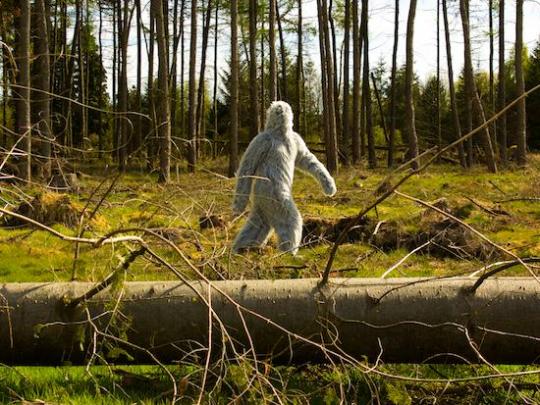
Mark Peter Wright – I, The Thing In The Margins, 2015, C-type Deluxe Print, Image courtesy of the artist
The delicious-sounding location of Onkalo, Finland is home to the world’s first deep geological repository for spent nuclear fuel. Still under construction, but designed to be operational for at least one hundred years once it is complete, this facility aims to tackle the problem of nuclear waste on a geological timescale. The half-life, or the rate of decay, of many nuclear isotopes can stretch into thousands of years, which means that nuclear waste will remain dangerous long after you and I have kicked the bucket. According to Michael Madsen’s 2010 documentary on the subject, Into Eternity: A Film For The Future, the nuclear waste stored at Onkalo will not be safe for another 100,000 years. This begs the question: As the cultural tide shifts back into acceptance of nuclear power as a ‘sustainable’ resource, how do you ensure that future generations become aware of the fact that this location is extremely dangerous?
Thank You For Your Patience, which premiered at the Hackney Showroom in July, is a play that attempts to answer this question by exploring the idea of intergenerational equity in relation to nuclear culture. Written and performed by Hector Dyer, with an accompanying soundtrack by Rob Morton, the work takes the Onkalo spent nuclear fuel repository as its principal starting point, before deviating into alternative narratives, one of which is set in an unnamed British village, and the other, in a harsh, but distant future.
The latter narrative tells the story of people who stumble across a contaminated geological repository. How do they interpret what they find? Building on Madsen’s film, Dyer’s monologues introduce the problem of semantics with respect to long-term nuclear storage solutions. Languages are constantly evolving and our understanding of semiotics can change significantly as generations succeed one another. The International Organization for Standardization (ISO) and the International Atomic Energy Agency (IAEA) recognised this problem and, in 2007, published a new symbol to represent the danger of ionising radiation, with the aim of replacing the old trefoil image with something more intuitive.
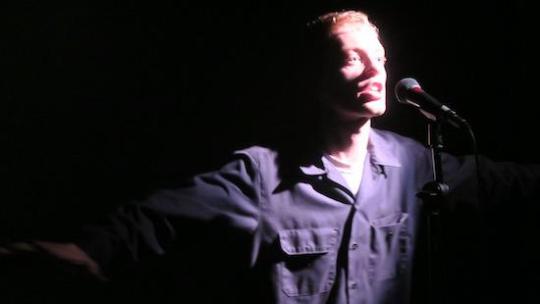
Rob Morton & Hector Dyer – Thank You For Your Patience, 2017, Photograph by George Galkin
Catching up with Morton and Dyer after their performance, I couldn’t help but ask them why it was that they found this subject intriguing enough to write a play about it. Crouching on a slither of artificial grass outside of the Hackney Showroom, Morton paused for a moment before answering: “The idea that you could leave a warning to people – they might even speak the same language, but [the message] just has no cultural meaning – gave us lots to work with”. Dyer continued his colleague’s train of thought: “We also felt that the concept of it being set 100,000 years [into the future] goes beyond our perception of time, and that allows you to write fiction that goes beyond our perception of what human beings will be”.
Whilst Dyer’s monologues deliver a wealth of dark and complex ideas, Morton’s soundtrack drives the play by providing a contextual backdrop and much needed colour. Rather than being a supporting agent, however, Morton's music comes to the foreground by melding together dubstep, jungle, vapourwave and field recordings. In the process, Morton’s electronic atmospherics recall sounds from a “deconstructed club scene, people like Total Freedom or Bala Club. It’s very noisy, aggressive stuff that’s meant to be played at nightclubs, but just isn’t danceable at all”.

Don’t Follow The Wind – A Walk In Fukushima, 2016-, 20th Sydney Biennale, Photograph by Leila Joy
A little research into the concept of nuclear culture reveals that Dyer and Morton are far from the only artists interested in exploiting the atom. The Nuclear Culture Sourcebook, edited by Ele Carpenter and published last year by Black Dog Publishing, is an excellent resource on the intersection of art and what Carpenter calls “the nuclear imaginary”. Concerning itself primarily with the visual arts, the book’s most chilling example of how far artists will go to highlight the dangers of nuclear power is film documentation from the Don’t Follow The Wind exhibition.
This collaborative show was initiated by the Japanese neo-Dada collective Chim-Pom. The collective assembled works by various artists, which related to nuclear culture, and exhibited them at various locations in the Fukushima Exclusion Zone. Due to the extreme contamination levels of the site it is impossible to tell when the exhibition will be open to the public. Its duration, therefore, is indefinite. However, the collective’s hand-made virtual reality headsets (above), most recently available to view at the Art Catalyst show Real Lives Half Lives: Fukushima, earlier this summer, are able to place the spectator right at the heart of the devastation, which followed the Fukushima Daiichi nuclear disaster of 2011.
youtube
Peter Cusack – Chernobyl Frogs, 2012, Field Recording
Working a little closer to home, the experimental musician, Peter Cusack, made field recordings of various nuclear sites, most notably inside the Chernobyl Exclusion Zone. Divorced from context, field recordings can often be a difficult sell, but Cusack provides a short blurb for each piece of audio. Compiled in the 2012 book, Sounds From Dangerous Places, these recordings offer a glimpse into a largely abandoned, eerie environment where nature has usurped mankind’s dominance, yet the invisible dangers of radiation linger in the background.
The theme of invisibility is also pervasive in the work of Mark Peter Wright, a sound artist whose main focus has been the exploration of the Anthropocene, a familiar theme to some readers of tQ. Whilst this new geological time period does not immediately suggest notions of the nuclear, Wright traces its proposed beginnings back to 1964, “which saw a peak in radioactive carbon following two decades of nuclear weapons testing”. Wright’s sound works rarely involve sound at all, but rather focus on its absence. His mutating microphone sculptures (Humanimentical Prototype) and wandering deadcat Sasquatch (I, The Thing In The Margins) suggest that, like Dyer, Wright is also interested in fictions that go beyond our perception.
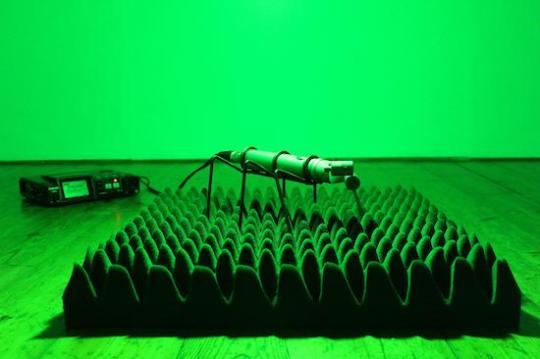
Mark Peter Wright - Humanimentical Prototype, 2015, Image courtesy of the artist
The Japanese cultural critic and art anthropologist Noi Sawaragi, who contributed an essay to The Nuclear Culture Sourcebook, summarised the close relationship of art to nuclear culture: “When people think of ‘art’ they imagine the visual arts, but like radioactivity, art too is invisible. When we encounter art, what we tend to see is merely the artwork-as-substance. And while the artwork-as-material is visible, we still might fail to appreciate the experience or meaning of the material that makes it art. We expect to experience an abstract power of art, something emanating, invisibly, one might say, almost like radiation”.
Although the nuclear industry takes strict precautions and reactor designs have improved over the years, Chernobyl and Fukushima prove that major accidents do happen. So do smaller, clearly avoidable ones. Furthermore, the gung-ho approach of the Trump administration to North Korea’s fits of attention seeking, coupled with the reactionary stance from the Labour party to Jeremy Corbyn’s attempts to scrap Trident, only go to show that we are still living in the Atomic Age. As our bold new century moves forward, I expect that issues relating to the "the nuclear imaginary" will increasingly become one of the primary concerns for socially conscious artists operating in sound, performance, and multimedia.
The Nuclear Culture Sourcebook is available now, published by Black Dog Publishing
Ilia Rogatchevski
Originally published by The Quietus, 13 August 2017
0 notes